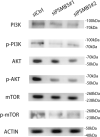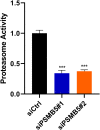PSMB5 overexpression is correlated with tumor proliferation and poor prognosis in hepatocellular carcinoma
- PMID: 36062301
- PMCID: PMC9623531
- DOI: 10.1002/2211-5463.13479
PSMB5 overexpression is correlated with tumor proliferation and poor prognosis in hepatocellular carcinoma
Abstract
Aberrant expression of members of the proteasome subunit beta (PSMB) family (including PSMB2, PSMB4, PSMB7 and PSMB8) has been reported in hepatocellular carcinoma (HCC). However the role of PSMB5 in HCC is unclear. To address this issue, we examined the expression of PSMB5 in HCC tissues using the The Cancer Genome Atlas, International Cancer Genome Consortium and Gene Expression Omnibus databases. A quantitative real-time PCR and immunohistochemistry were performed to validate the expression of PSMB5 in HCC. The survival mutation status and immune cell infiltration of PSMB5 were also evaluated in HCC. We then examined the effect of knocking down PSMB5 expression through RNA interference in the HCC cell line Huh7. High expression of PSMB5 was observed in HCC tissues and was associated with poor prognosis. PSMB5 expression and clinical characteristics were then incorporated to build a prognostic nomogram. We observed that PSMB5 expression was closely related to the abundance of B cells, CD4+ T cells, CD8+ T cells, dendritic cell macrophages and neutrophils. Moreover silencing of PSMB5 in Huh7 significantly suppressed cell proliferation and migration at the same time as increasing apoptosis. Inhibition of the phosphatidylinositol-3-kinase/Akt/mechanistic target of rapamycin pathway was observed after PSMB5 downregulation in Huh7 cells. Our findings suggest that PSMB5 may promote the proliferation of HCC cells by inactivating the phosphatidylinositol-3-kinase/Akt/mechanistic target of rapamycin signaling pathway and thus PSMB5 may have potential as a biomarker for diagnosis and prognosis of HCC.
Keywords: PSMB5; diagnosis; prognosis; proliferation and hepatocellular carcinoma.
© 2022 The Authors. FEBS Open Bio published by John Wiley & Sons Ltd on behalf of Federation of European Biochemical Societies.
Conflict of interest statement
The authors declare that they have no conflicts of interest.
Figures











Similar articles
-
Carboxypeptidase A6 Promotes the Proliferation and Migration of Hepatocellular Carcinoma by Up-regulating AKT Signaling Pathway.Curr Med Sci. 2019 Oct;39(5):727-733. doi: 10.1007/s11596-019-2098-z. Epub 2019 Oct 14. Curr Med Sci. 2019. PMID: 31612389
-
Rpn10 promotes tumor progression by regulating hypoxia-inducible factor 1 alpha through the PTEN/Akt signaling pathway in hepatocellular carcinoma.Cancer Lett. 2019 Apr 10;447:1-11. doi: 10.1016/j.canlet.2019.01.020. Epub 2019 Jan 20. Cancer Lett. 2019. PMID: 30673593
-
As a downstream target of the AKT pathway, NPTX1 inhibits proliferation and promotes apoptosis in hepatocellular carcinoma.Biosci Rep. 2019 Jun 4;39(6):BSR20181662. doi: 10.1042/BSR20181662. Print 2019 Jun 28. Biosci Rep. 2019. PMID: 31113871 Free PMC article.
-
Rab31 promoted hepatocellular carcinoma (HCC) progression via inhibition of cell apoptosis induced by PI3K/AKT/Bcl-2/BAX pathway.Tumour Biol. 2015 Nov;36(11):8661-70. doi: 10.1007/s13277-015-3626-5. Epub 2015 Jun 6. Tumour Biol. 2015. PMID: 26044564
-
Comprehensive Analysis of Prognostic Value and Immune Infiltration of Src Family Kinases in Hepatocellular Carcinoma.Front Biosci (Landmark Ed). 2023 May 11;28(5):90. doi: 10.31083/j.fbl2805090. Front Biosci (Landmark Ed). 2023. PMID: 37258470
Cited by
-
PHD-BAH Domain in ASH1L Could Recognize H3K4 Methylation and Regulate the Malignant Behavior of Cholangiocarcinoma.Anticancer Agents Med Chem. 2024;24(17):1264-1274. doi: 10.2174/0118715206312004240712072532. Anticancer Agents Med Chem. 2024. PMID: 39034728
-
Actinomycin D and bortezomib disrupt protein homeostasis in Wilms tumor.bioRxiv [Preprint]. 2024 Dec 17:2024.06.11.598518. doi: 10.1101/2024.06.11.598518. bioRxiv. 2024. PMID: 38948702 Free PMC article. Preprint.
-
Integrated Analysis of PSMB8 Expression and Its Potential Roles in Hepatocellular Carcinoma.Dig Dis Sci. 2025 Aug;70(8):2719-2738. doi: 10.1007/s10620-025-09040-9. Epub 2025 Apr 22. Dig Dis Sci. 2025. PMID: 40261568
-
MiR-383 sensitizes osteosarcoma cells to bortezomib treatment via down-regulating PSMB5.Mol Biol Rep. 2024 Jan 22;51(1):170. doi: 10.1007/s11033-023-08964-7. Mol Biol Rep. 2024. PMID: 38252234
-
Extracellular Vesicles in Diffuse Large B Cell Lymphoma: Characterization and Diagnostic Potential.Int J Mol Sci. 2022 Nov 1;23(21):13327. doi: 10.3390/ijms232113327. Int J Mol Sci. 2022. PMID: 36362114 Free PMC article.
References
-
- Llovet JM, Zucman‐Rossi J, Pikarsky E, Sangro B, Schwartz M, Sherman M, et al. Hepatocellular carcinoma. Nat Rev Dis Primers. 2016;2:16018. - PubMed
-
- Sung H, Ferlay J, Siegel RL. Global cancer statistics 2020: GLOBOCAN estimates of incidence and mortality worldwide for 36 cancers in 185 countries. CA Cancer J Clin. 2021;71:209–49. - PubMed
-
- Zhou J, Yu L, Gao X, Hu J, Wang J, Dai Z, et al. Plasma microRNA panel to diagnose hepatitis B virus‐related hepatocellular carcinoma. J Clin Oncol. 2011;29:4781–8. - PubMed
Publication types
MeSH terms
Substances
LinkOut - more resources
Full Text Sources
Medical
Molecular Biology Databases
Research Materials
Miscellaneous

